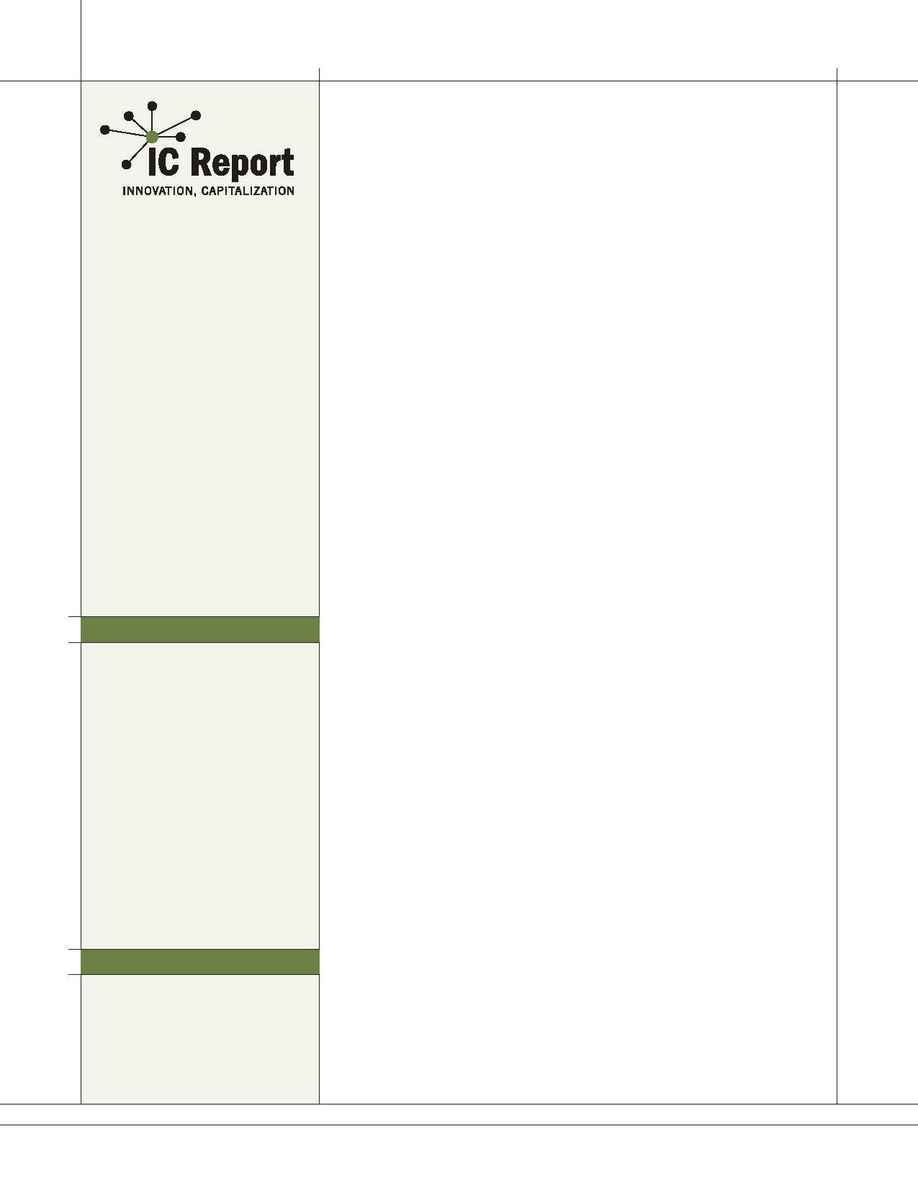
Red Herring, Inc.
1931 Old Middlefield Way, Suite F
Mountain View, CA 94043
phone: 650.428.2900
email: ICReport@redherring.com
web: www.redherring.com
editors: Lee Bruno
Tim Devaney
contributing editors: Tom Stein
Maryann Thompson
contributing writers: Niall McKay
Will Wade
design & production: Annette Leong
IC Report is published 12 times per year.
Annual subscription rate is $399. Single issue
price is $99.
Copyright © 2004 Red Herring, Inc. / IC Report
ISSN: 1547-3872
Reproduction in any form prohibited
without permission.
go from concept to product."
Frost & Sullivan predicts that the sectors to watch during the next few years
will be cardiovascular (including the aforementioned dr ug-eluting stents),
orthopedics, antimicrobial devices, pain management, neurology and minimally
invasive applications.
Growth in the cardiovascular market is almost inevitable. Heart disease
remains a leading cause of death among people in industrialized countries and,
as a result, cardiovascular business will grow significantly in coming years, says
Frost & Sullivan's Bohora, especially in the areas of inter ventional cardiology
and less-invasive surger y. But he adds that the sector is extremely competitive
and fast changing.
For instance, early-stage startup Polymerix has developed a new class of arterial
stents that could significantly alter the market for these devices (see page 5).
Polymerix has come up with a polymer coating for stents that eases the temporary
trauma often sustained by the artery during implantation. But the real breakthrough
is the coating's ability to deliver a slow dose of medicine to the patient as the coating
dissolves in the bloodstream.
Such innovation is now common in the medical device industr y, says Bohora,
who points out that more than 80 percent of device companies have 50 or fewer
employees and 98 percent have fewer than 500.
"Newer companies have the fire and come up with the innovative technologies,"
he says. "The downside is that many of the smaller companies don't have the
resources to sustain themselves through the clinical trials."
As a result, there is now a trend toward consolidation, with more ahead, Bohora
says: "Small companies that don't have the resources to market a product but do
have superior technology are seeing bigger companies investing in them."
The emerging synergy between the life sciences and silicon technologies is also
evident in the research field. Palo Alto Research Center and Scripps Research
Institute recently struck a two-year partnership whose goal is to accelerate advances
in the life sciences arena. The plan is to leverage both institutions' strengths
PARC's prowess in physics, imaging, mathematics, information sciences and engi-
neering, and Scripps' biomedical expertise.
"At PARC we do technology and they do ver y little tech. But they do
biotech, so it's highly complementar y," says Richard Br uce, director of the
Scripps-PARC alliance.
The Institute for Advanced Biomedical Studies recently debuted one result of
the Scripps-PARC collaboration: a fiber array scanning technology system that
detects and monitors cancer through high-speed blood testing. FAST employs
PARC's expertise in lasers and optical micromechanical systems to help detect cancer
cells 1,000 times quicker than traditional digital microscopes. The FAST cytometer
invented by the Scripps-PARC team can analyze a sample in two minutes, much less
than the 16 to 32 hours required by digital microscopy.
Another recent partnership that brings together computing and biology is the
NanoSystems Biology Alliance, established last year by the Institute for Systems
Biology, Caltech and UCLA. The NSBA boasts a powerful collection of scientists,
including Leroy Hood, president and cofounder of the Institute for Systems
Biology; Michael Phelps of UCLA; and Stephen Quake, a physicist with Caltech.
The group's goal is to attack challenges in cancer and immunology and ultra-
rapid disease. To do it, the NSBA is employing emerging technologies from the
world of nanotechnology and methodologies from systems biology, which means
coordinated measurement of thousands of molecular signatures of genes and pro-
teins. By decoding the cancer and immune responses, the NSBA scientists hope to
be able to diagnose cancer much earlier in its life cycle.
It is these sorts of relationships that will push the boundaries of biomedical tech-
nology today and spin off the startups of tomorrow, opening new markets for
entrepreneurs and opportunities for investment by VCs.
q
2
COMING UP IN IC REPORT
JUNE:
Software
JULY:
Energy
AUGUST:
Materials
SEPTEMBER:
Electronics
ABOUT IC RATINGS
Each IC Repor t technology profile
includes an IC Rating of that tech-
nology's innovation, capitalization
and market oppor tunity. The editors
of IC Repor t determine the IC
Rating by looking at each tech-
nology's fundamentals and potential.
Innovation is a measure of the degree
to which a new technology is dif-
ferent from existing technologies in
its field. Capitalization is an appraisal
a startup's funding progress toward a
marketable product. Market oppor-
tunity is an estimate of that product's
market potential.
